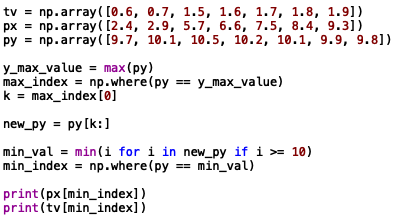Groupby minimum in pandas python can be accomplished by groupby() function. Groupby minimum of multiple column and single column in pandas is accomplished by multiple ways some among them are groupby() function and aggregate() function. let’s see how to
- Python Np Min Index
- Array Min Index Python
- Python Find Min Index In List
- Python Min Index Of 2d Array
- Python List Min Element Index
- Python Min Index Statement
- Python’s numpy module provides a function to get the minimum value from a Numpy array i.e. Numpy.amin(a, axis=None, out=None, keepdims=, initial=).
- Through indexing, you can retrieve an item or range of items from a list. You can only retrieve a specific item from a list if you know the index number associated with that value. To find the index value of the largest item in a list, you can use the max and index methods.
- Python List index The index method returns the index of the specified element in the list. The syntax of the list index method is: list.index(element, start, end) list index parameters. The list index method can take a maximum of three arguments: element - the element to be searched.
- Groupby single column in pandas – groupby minimum
- Groupby multiple columns in pandas – groupby minimum
- Groupby minimum using aggregate() function
- Groupby minimum using pivot() function.
- using reset_index() function for groupby multiple columns and single columns
The min function returns the item with the lowest value, or the item with the lowest value in an iterable. If the values are strings, an alphabetically comparison is done.
First let’s create a dataframe
df1 will be
Groupby single column – groupby min pandas python:
groupby() function takes up the column name as argument followed by min() function as shown below
We will groupby min with single column (State), so the result will be
Python Np Min Index
using reset_index()
reset_index() function resets and provides the new index to the grouped by dataframe and makes them a proper dataframe structure
Array Min Index Python
We will groupby min with “State” column along with the reset_index() will give a proper table structure , so the result will be
Groupby multiple columns – groupby min pandas python:
We will groupby min with State and Product columns, so the result will be
Groupby Min of multiple columns in pandas using reset_index()
reset_index() function resets and provides the new index to the grouped by dataframe and makes them a proper dataframe structure
We will groupby min with “Product” and “State” columns along with the reset_index() will give a proper table structure , so the result will be

Using aggregate() function:
agg() function takes ‘min’ as input which performs groupby min, reset_index() assigns the new index to the grouped by dataframe and makes them a proper dataframe structure
We will compute groupby min using agg() function with “Product” and “State” columns along with the reset_index() will give a proper table structure , so the result will be
using Pivot() function :
You can use the pivot() functionality to arrange the data in a nice table.
groupby() function along with the pivot function() gives a nice table format as shown below
Short answer: To find the minimal list in a list of lists, you need to make two lists comparable. How? With the key argument of the min() function. The key argument is a function that takes one input (a list) and returns one output (a numerical value). The list with the smallest numerical value is returned as the minimum of the list of lists.
Problem: Say you have a list of lists (nested list) and you want to find the minimum of this list. It’s not trivial to compare lists—what’s the minimum among lists after all? To define the minimum among the inner lists, you may want to consider different objectives.
- The first element of each inner list.
- The i-th element of each inner list.
- The sum of inner list elements.
- The maximum of inner list elements.
- The minimum of inner list elements.
Example: Given list of lists [[1, 1, 1], [0, 2, 0], [3, 3, -1]]. Which is the minimum element?
Python Find Min Index In List
- The first element of each inner list. The minimum is
[0, 2, 0]. - The i-th element of each inner list (
i = 2). The minimum is[.3, 3, -1] - The sum of inner list elements. The minimum is
[.0, 2, 0] - The maximum of inner list elements. The minimum is
[1, 1, 1]. - The minimum of inner list elements. The minimum is
[3, 3, -1].
So how do you accomplish this?
Solution: Use the min() function with key argument.
Syntax: The min() function is a built-in function in Python (Python versions 2.x and 3.x). Here’s the syntax:
min(iterable, key=None)
Arguments:
Let’s study the solution code for our different versions of calculating the minimal “list” of a list of lists (nested list).
Try it yourself in our interactive code shell:
Related Video:
Related articles:
Where to Go From Here?
Enough theory, let’s get some practice!
To become successful in coding, you need to get out there and solve real problems for real people. That’s how you can become a six-figure earner easily. And that’s how you polish the skills you really need in practice. After all, what’s the use of learning theory that nobody ever needs?

Practice projects is how you sharpen your saw in coding!
Do you want to become a code master by focusing on practical code projects that actually earn you money and solve problems for people?
Then become a Python freelance developer! It’s the best way of approaching the task of improving your Python skills—even if you are a complete beginner.
Join my free webinar “How to Build Your High-Income Skill Python” and watch how I grew my coding business online and how you can, too—from the comfort of your own home.
Python Min Index Of 2d Array
While working as a researcher in distributed systems, Dr. Christian Mayer found his love for teaching computer science students.
Python List Min Element Index
To help students reach higher levels of Python success, he founded the programming education website Finxter.com. He’s author of the popular programming book Python One-Liners (NoStarch 2020), coauthor of the Coffee Break Python series of self-published books, computer science enthusiast, freelancer, and owner of one of the top 10 largest Python blogs worldwide.
His passions are writing, reading, and coding. But his greatest passion is to serve aspiring coders through Finxter and help them to boost their skills. You can join his free email academy here.
Python Min Index Statement
Related Posts
